
If you will, picture CakeSpy and a buddy walking by the beach with soft lighting:
CakeSpy: Have you ever tried kugel?
Buddy: Isn't that like, an excercise...for your female parts?
CakeSpy: No! It's a noodle pudding!
Buddy: Is that a euphemism?
Clearly, it's time to set the record straight about kugel.
What is it? Simply put, kugel is noodle pudding. Grossed out? Get over it by giving a long, hard look at its more popular friends and neighbors like bread pudding and rice pudding.
Need more information? Literally translated, "Kugel" (or, if you're speaking Yiddish, קוגעל) means "ball", but apparently this translation also sometimes means "pudding" or "casserole"--according to Wikipedia, this may be a reference to "the round, puffed-up shape of the original dishes (compare to German Gugelhupf — a type of ring-shaped cake)". These days, the dish is generally baked in a square or rectangle pan, but apparently the name stuck. But back to the dish.
Directions:
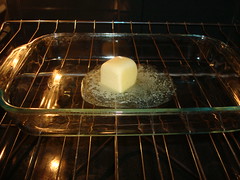
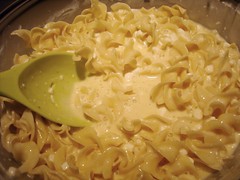
In a 9 x 13 pan melt butter in a 350 degree oven. In a large bowl, mix eggs, sugar, sour cream, cottage cheese, noodles & vanilla (I used some from a local company called Singing Dog, who recently sent me a sample) and cinnamon, if desired. Remove pan of butter from oven & pour in egg & noodle mixture.
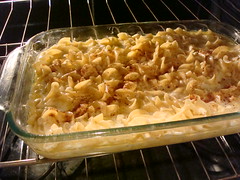
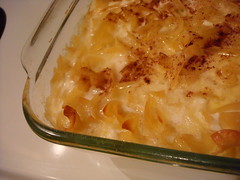
Bake at 350 degrees for 45 minutes to 1 hour. Serve warm.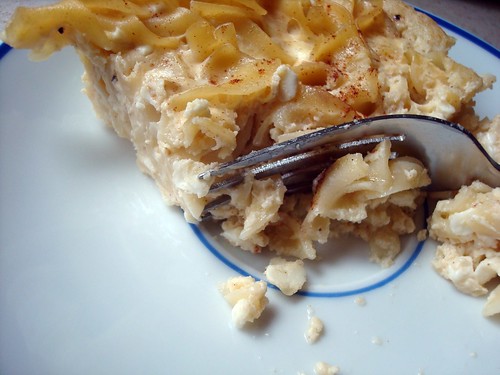
How did it come to be? Well. According to Jewishrecipes.org,
Made from bread and flour, the first kugels were plain, and salty rather than sweet. About 800 years ago, their flavor and popularity improved when cooks in Germany replaced bread mixtures with noodles or farfel. Eventually eggs were incorporated. The addition of cottage cheese and milk created a custard-like consistency which is common for today's dishes.Apparently though it wasn't til the 1600s that its potential as a sweet dish was realized:
In the 17th century, sugar was introduced, giving home cooks the option of serving it as a side dish or dessert. In Poland, Jewish women sprinkled raisins and cinnamon into recipes. Hungarians took the dessert concept further with a hefty helping of sugar and some sour cream.Why is it popular? Well, aside from being delightfully carbohydratey and delicious, sweet kugel is also rich in tradition. It's long been associated with Rosh Hashanah, a holiday on which sweet foods symbolically represent a sweet new year ahead. Naturally, it was also a cinch for popularity as a traditional dessert to serve straightaway following the Yom Kippur fast
, which is traditionally broken with a dairy meal.
Here are some other things that might interest you about kugel:
- First off, it's the reason we have the bundt pan! According to this article, in the early days of Nordic Ware,
immigrant Jewish women asked if the company could make a specialty pan that could be found only in Europe. The women tried to explain the pan, used to make a pudding called Kugel, by using a word that sounded like "bunt" and meant "a gathering of people," David Dalquist said. And the fluted, cast-aluminum design -- trademarked as a Bundt pan -- was born.(CakeSpy Note: Of course, it wasn't 'til 1966 when the Tunnel of Fudge cake, a winning entry to the Pillsbury Bake-Off contest, really popularized the pan...but hey, kugel paved the way!)
- Second, did you know that it also has mystical powers? According Allan Nadlar, a professor of religious studies at Drew University, in a 2005 NY Times article:
According to Hasidic interpretations of Kabbalah mysticism...kugel has special powers.
"Clearly the spiritual high point of the meal is the offering of the kugel," Professor Nadler said. At that moment the rabbi has the power to bestow health and food, and even to help couples conceive.
- In the late 19th century, Jerusalemites combined caramelized sugar and black pepper in a noodle kugel known as Jerusalem kugel, which is a commonly served at Shabbat kiddushes.
- Finally, if you're "Crazy for Kugel", you can find more tips and trivia on the Manishewitz website.
- 3 eggs
- 1/2 cup sugar
- 1 pint sour cream
- 1 pint cottage cheese
- 6 ounces wide noodles, cooked
- 1 tablespoon vanilla
- 1/4 cup butter
- Cinnamon, to taste
Directions:


In a 9 x 13 pan melt butter in a 350 degree oven. In a large bowl, mix eggs, sugar, sour cream, cottage cheese, noodles & vanilla (I used some from a local company called Singing Dog, who recently sent me a sample) and cinnamon, if desired. Remove pan of butter from oven & pour in egg & noodle mixture.


Bake at 350 degrees for 45 minutes to 1 hour. Serve warm.

